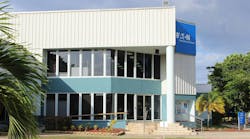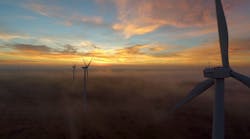In certain regions of the United States, wind energy has become a powerful energy resource that produces power at competitive rates and offers electrical contractors a new niche business opportunity.
When travelers drive west along California's I-10 through the San Gorgonio Pass, a singularly spectacular sight greets them. Several thousand wind turbines tower above the desert floor and the slopes of 10,815-ft Mt. San Jacinto and 11,451-ft Mt. San Gorgonio. If travelers stop alongside the road near one of these wind farms, they can often hear the steady soft whirring sound of these three-bladed turbines collecting the 14-mph to 20-mph winds as they funnel through this mountain pass, and harvest this natural resource by converting it into over 600 million kWh annually. It's enough electricity to power all of the homes in nearby Palm Springs.
It also may be a potential business opportunity for electrical contractors and distributors with an ear for new markets, especially if they live in the regions of the United States where wind energy can be harvested and sold at electrical rates that are dead-on competitive with the power produced by traditional coal-fired power plants. Spurred on by a need for more power production-as well as enticing financial incentives in some states-the wind industry is coming off its biggest year ever. In 1999, 925mW of capacity was installed, which is more than twice the amount added in any other year. In addition, 200mW of existing capacity was replaced with more efficient and more powerful turbines. California, Iowa and Minnesota saw the most large-scale activity, but sources say the installation of smaller wind turbines by homeowners is also on the rise.
In total, wind turbines produced about 2,500mW in 1999 and are expected to produce 2,650mW this year-enough to power more than 800,000 households, according to the American Wind Energy Association (AWEA), Washington, D.C. Internationally, Denmark, Germany and Spain are on major construction campaigns to add wind energy to their power grids.
The Upper Midwest has some of the best potential as a wind-generating region, said Ken Hach, Midwest regional manager for Enron Wind Corp., Storm Lake, Iowa. "There is a huge wind resource out in the Midwest and the Great Plains," he said. "The problem is that where we have the great winds we don't have the people. In the future, we have to build the transmission to get the generation to the people." Industry experts agree that wind business won't be a big market opportunity for contractors unless they live in a region where wind energy can be produced at rates that compete with the power produced by traditional means.
"With 20 years running time on turbines, we have gotten the cost down from 18 to 19 cents per kWh to 3 cents per kWh," Hach said.
Wind turbines account for a relatively small percentage of business for Chuck Marken, president of AAA Solar Service and Supply, Albuquerque, N.M., but he does install the systems for homeowners and promote them in his online catalog at www.aaasolar.com.
"Wind is more popular with grid-type things," he said. "It's already that way in Europe. You can't put a wind turbine anywhere. But if you have a good wind resource, you can take a site and make it a central generating facility that feeds into the grid. It's just like an electric plant. Wind energy has a good possibility within the next 20 years."
Marken, who was an electrical contractor before starting up AAA Solar Service and Supply, said the wiring for wind generators is not any different than traditional power wiring and that the electrical systems for wind turbines must be wired according to the National Electrical Code. He said the smaller wind generators installed by homeowners generally produce DC power that must be converted into AC through inverters, but larger turbines produce three-phase power. The power produced depends on the speed of the wind and the size of the blades on the turbine that collects the wind.
Homeowners with an interest in wind turbines also often install photovoltaic systems, too, said Randy Henk, president, Natural Energy Systems, White Bear Lake, Minn. "A combination of wind and solar is the way to go in Minnesota," he said. "There's not a lot of sun in the winter, but there's a decent wind resource. The solar works fine in the summers here. Wind and solar complement each other well."
Tim Harrington, a homeowner in Blue Springs, Mo., uses a wind turbine and photovoltaic array to supplement and backup the power that he draws from the utility grid. He needs 80kW of electricity a day to run his house, and he gets about 2kW each day from his wind turbine and 12 kW from the solar electricity that he generates. Harrington stores the power that the wind turbine and solar panels produce in batteries in his garage. This market looks poised for some solid growth, but the activity will be in several regional pockets, such as California, Iowa, Minnesota and Texas. Wiring wind turbines can be an interesting sideline for contractors if they live in these market areas. Distributors in these markets may see some business from contractors and utilities involved in the installation of these systems, but outside of these regions, the most they will probably see is some occasional business from homeowners.








